By Ranjita Biswas
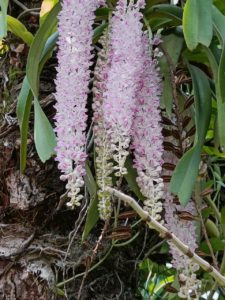 Strands of pink Kopou flower and the yellow Bhatou hanging from trees like garlands told us during the growing up years in Assam that Rangali Bihu, the Spring festival of Assam, was round the corner. In olden days women dancing the Bihu used to adorn their hair with these flowers.
Strands of pink Kopou flower and the yellow Bhatou hanging from trees like garlands told us during the growing up years in Assam that Rangali Bihu, the Spring festival of Assam, was round the corner. In olden days women dancing the Bihu used to adorn their hair with these flowers.
So I was no stranger to the beautiful tropical flower. But a recent visit to the annual Orchid Show at the Botanical Garden, New York, showed me how little I knew about the flower.
This annual show is a high point in New York’s social calendar, loved by locals, tourists and connoisseurs.
It was paused during the last two years due to the pandemic but the 19th year exhibition this year titled The Orchid Show: Jeff Leatham’s Kaleidoscope more than made up for it. Leatham is known for being a lifestyle icon and floral designer for the cognoscenti. At the historic Enid A. Haupt Conservatory in the garden, thousands of orchids in myriad varieties were on display in dazzling creations in a Kaleidoscope of colours at galleries spread over different levels and a lily pool.
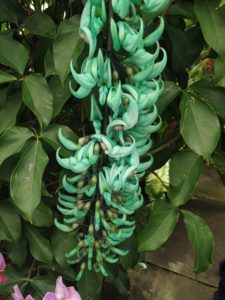 The flowers for the show were sourced from around the world and needed months of planning. Interspersed in the show were helpful maps to show the place of origin of the particular variety and other information. For example, in a long border lined with snow –white orchids, aptly named Moonlit Orchid, you read that it, and some light coloured orchids, evolved to attract nocturnal pollinators. Their pale colour reflects the moonlight and is visible to moths which can distinguish only light and dark. Like many white flowers in India they also release a strong fragrance at night.
The flowers for the show were sourced from around the world and needed months of planning. Interspersed in the show were helpful maps to show the place of origin of the particular variety and other information. For example, in a long border lined with snow –white orchids, aptly named Moonlit Orchid, you read that it, and some light coloured orchids, evolved to attract nocturnal pollinators. Their pale colour reflects the moonlight and is visible to moths which can distinguish only light and dark. Like many white flowers in India they also release a strong fragrance at night.
The name Orchid was coined by Theophrastus (370-285 BC), known as the ‘Father of Botany’ taking from orchis (Greek for testicle) based on the resemblance of paired underground tubers of the plants to the male anatomy. Because of this resemblance, people have the wrong notion that orchids possess aphrodisiac properties. These plants are perennial herbs with simple leaves.
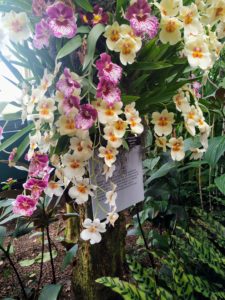 All orchids are listed in the Endangered Species of Wild Fauna and Flora of the Convention of International Trade (CITES).
All orchids are listed in the Endangered Species of Wild Fauna and Flora of the Convention of International Trade (CITES).
The family ‘Orchidaceae’ constitutes one of the largest families of flowering plants. They are a highly evolved family, with 600-800 genera and 25,000-35,000 species all over the globe.
Orchids are classified into three categories: epiphytic (plants that grow on another plant and rock boulders), terrestrial (plants that grow on land and climbers) and mycoheterotrophic (plants that derive nutrients from mycorrhizal fungi that are attached to the roots of a vascular or flowing plant).
They appear in an astonishing range of sizes and colours. Some are no bigger than the thumbnail, while others are the size of a palm. Some mimic bees and butterflies, while others resemble a lady’s slipper (in Roman mythology this orchid grew from a goddess’s lost slipper). Their variety indicates that the flowers adopt different sizes and appearances for cross-pollination, what Charles Darwin called an ‘endless variety of structure.’ 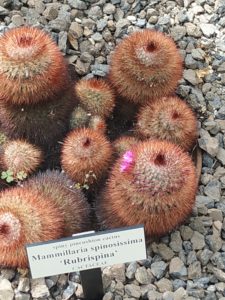 He observed and examined orchids to find out which insects pollinated specific orchids. When he found an orchid in Madagascar which holds nectar at the end of a long tube, he predicted that a moth with an extra-long mouth must be pollinating it. Forty years later, the discovery of Wallace’s Sphinx in the island confirmed his hypothesis.
He observed and examined orchids to find out which insects pollinated specific orchids. When he found an orchid in Madagascar which holds nectar at the end of a long tube, he predicted that a moth with an extra-long mouth must be pollinating it. Forty years later, the discovery of Wallace’s Sphinx in the island confirmed his hypothesis.
Orchids are found in different regions of Africa, Asia, the Caribbean, and the Americas. They have evolved to survive in astonishing places, even in deserts as I discovered in a special corner of the Conservatory. Like a few species thriving in dry areas of northern Peru, growing on cacti. In parts of Central America one species is found growing on mangrove roots,
In India, it is said that people have known orchids since the Vedic period for its medicinal property. Even in countries of the West Indies, Malaysia, etc., orchids or parts of the plant are used for a variety of indigenous medicines.
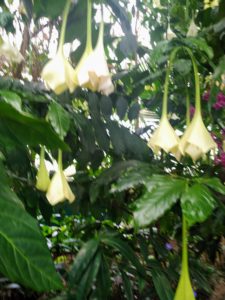 The Botanical Survey of India estimates through a study family that there are 1,256 species in India. Of them belonging to 155 genera, 388 species are endemic to India.
The Botanical Survey of India estimates through a study family that there are 1,256 species in India. Of them belonging to 155 genera, 388 species are endemic to India.
The Himalayas have the maximum orchid species among the ten bio-geographic zones of India. They are followed by the North East, Western Ghats, Deccan Plateau and Andaman and Nicobar Islands, respectively.
Arunachal Pradesh and Sikkim have established orchid sanctuaries, regions known for being ‘Orchid Paradise’. Assam has its Deorali Orchid Sanctuary.
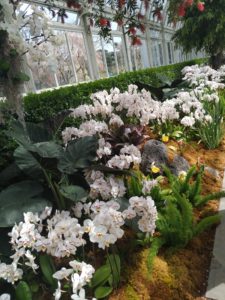 Smuggling out the species from these regions is punishable by law. In the past police have busted many international gangs trying to smuggle out species endemic to the regions.
Smuggling out the species from these regions is punishable by law. In the past police have busted many international gangs trying to smuggle out species endemic to the regions.
Orchids are considered as indicators of the health of the forest ecosystem. Generally, the seeds require four to five years or more to attain flowering stage and so they are not abundant in supply. Rapid destruction of natural habitat by deforestation, forest fire, overgrazing, felling of trees, rapid urbanisation and indiscriminate collection for floral business make them even more endangered.
Trans World Features



